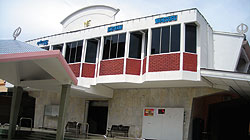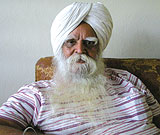SEREMBAN GURDWARA
|
“I now have a brick and I will make my palace soon. I now have a piece of land and I will make my kingdom soon.”
—Anonymous
|
|
By Amitabh Dixit in Kuala Lumpur
|
|
|
This anonymous saying is a beautiful tribute to the spirit of Sikhs based in Malaysia. The very visible presence of the Sikh community in Malaysia has its origins in the latter half of the 19th century. That was a time when the British Army recruited Sikhs and posted them in places such as Penang, Manting and Seremban. The Sikh Regiment was tasked to protect British business interests, especially the rich mines of Malaysia.
It came as no surprise that because of its hardworking nature and engaging mindset, the Sikh community quickly won the respect of the British. A piece of land was donated near the railway station to the Sikh community for building a Gurdwara. In 1905, Gurdwara shifted to its current location—Seremban, Jalan Templer. While the foundation was laid by the British, the management was taken over by Sikhs, mainly those in uniform. Since Malaysia’s independence in 1957, nearly 600 Sikh police officers have resided here.
|
|
|
 |
 |
| Seremban Gurdwara, Malaysia |
Sardar Payara Singh |
|
|
|
Legend has it that in 1942 when the Japanese attacked and occupied
Seremban, a Japanese soldier hurt a Sikh woman because she refused to bow her head. Not to take such an affront lightly, the Sikh community grouped together, and demanded that the Japanese soldier atone for what he’d done. It is said that soon after the Japanese Army funded rations for the
Gurdwara. For the next few years matters remained cordial. Attempts may also have been made to link the Japanese to the Azad Hind Fauj led at the time by Netaji Subhas Chandra
Bose.
The Gurdwara is also a symbol of the multiculturalism, and multi-ethnic fabric of Malaysian society. In the vicinity are a Church and a Hindu Temple. People from all walks come in to bow before the Granth Sahib and connect with the Highest Consciousness. The story of Sardar Pyara Singh is interesting. He arrived in Malaysia in 1949, and twenty years later became deeply associated with the Seremban
Gurdwara, remaining its president of the Gurdwara Committee till as late as 2005. He has seen the change.
After Malaysia’s independence, the Government helped out with the renovation of the
Gurdwara. Then the community pooled in its resources, though not for the first time. Back in the 1920s with Malaysian and world economy on a severe downturn, there were those that sold their jewellery and personal belongings, and livestock to support the Gurdwara’s activities. It is the same spirit that today the Gurdwara finds support from at least 500 families. Sardar Pyara Singh has seen things grow, brick by brick. The money has come in generously too. Renovations amounting to USD 600,000 have been carried out. Over 40 per cent of this amount has come from the local people. USD 40,000 has been spent on a computer laboratory. There are residential halls where people come to stay from all parts of the world. A kitchen hall is given to people outside the community to hold marriage parties, free of cost.
Says Sardar Pyara Singh, “the Gurdwara has helped to propagate values of Sikhism. It is not only about bearing the 5 Ks, it is about living a life of values. We regularly hold
kirtans, music classes, sporting activities and invite the high thinkers to convey ideas of spiritual
upliftment.”
The Seremban Gurdwara is indeed a place of eternal wisdom.
|
|
|
| |
|
|
|
April 2011
|
|


|
|
|
|